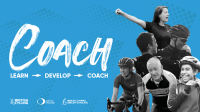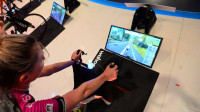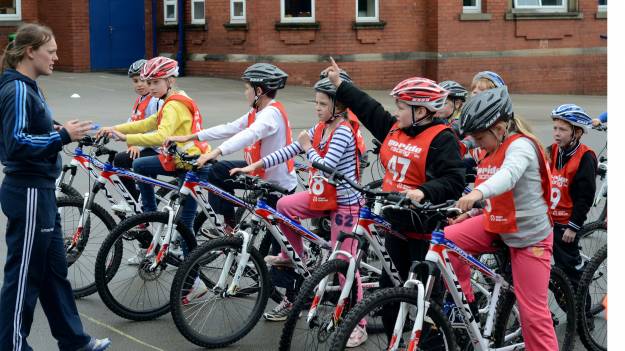CPD: Coach Led Racing
Success in most cycling events requires riders to be able to make the right decision at the appropriate point. This requires riders to be both technically proficient, as well as tactically versatile. Typically, riders will experiment and reflect on the technical and tactical decisions following each event they have attended. Riders may also read magazine articles on tactics and watch television coverage of bike races. However, very few riders will actually go out and practice their technical and tactical performance in training. This months CPD article presents the concept of Coach-led Racing, which can help develop your rider's technical and tactical aspects of performance.
What is Coach-led Racing? Coach-led Racing is racing role-play that allows techniques and tactics to be practised within a coaching session by creating a mock racing scenario. Any scenario can be used so long as you can create an environment in which your riders can learn from. Scenarios should be based around a crux moment from a race, so that your riders can practice making decisions in these important moments. For this reason, you may chose to practice a specific situation from your rider's last race or prepare them for a typical situation they may encounter within their discipline (such how to deal with being outnumbered by another team in a breakaway). You may even decide to recreate a decisive point from a major event, such the World Track Championships, or even a stage of the Tour de France.
Coach-led Racing is racing role-play that allows techniques and tactics to be practised within a coaching session by creating a mock racing scenario. Any scenario can be used so long as you can create an environment in which your riders can learn from. Scenarios should be based around a crux moment from a race, so that your riders can practice making decisions in these important moments. For this reason, you may chose to practice a specific situation from your rider's last race or prepare them for a typical situation they may encounter within their discipline (such how to deal with being outnumbered by another team in a breakaway). You may even decide to recreate a decisive point from a major event, such the World Track Championships, or even a stage of the Tour de France.
Within a group, one or two designated riders should each be assigned a specific tactic or technique to be used at a point in the scenario. Following the scenario, the coach should feedback to all riders, so that not only the designated riders, but all riders involved understand too.
Scenarios should be repeated several times within a session, with different riders being given the opportunity to experiment with the assigned techniques or tactics. This not only gives all riders an opportunity to be a designated rider, but enables the group to benefit from their feedback and experience throughout the session. Coaches' feedback should help the riders to focus on when, how and why a technique or tactic was performed, and what the appropriate response should have been.
Organisation of Coach-led Racing sessions
Coach-led Racing is racing role-play. It is important to understand that scenarios should replicate a segment of a race, and need not represent an entire race from start to finish. Therefore, scenarios can be run over a designated portion of a course, or they could represent a condensed race, using a shortened circuit.
 It is important that all riders within the scenario can benefit from the actions of the designated riders. For this reason, it is important to have no more than one or two designated riders with actions to perform. If you have two designated riders with actions within one scenario, ideally their technique or tactic should be related, i.e. one rider attacking and one rider responding to an attack.
It is important that all riders within the scenario can benefit from the actions of the designated riders. For this reason, it is important to have no more than one or two designated riders with actions to perform. If you have two designated riders with actions within one scenario, ideally their technique or tactic should be related, i.e. one rider attacking and one rider responding to an attack.
Technical and tactical instructions should be given discreetly to the designated riders so that the other riders in the group are unaware of their planned actions. Other riders within the session should participate as if it were a normal race. Riders should be reminded that the purpose of the activity is to develop technical and tactical performance, rather than beating other riders. For this reason, stronger riders should be asked to ‘hold back' with their effort to give less fit riders an opportunity to fulfil their technical or tactical goal.
Also, and most importantly, it should be remembered that riders can learn from both successful and unsuccessful performances. Therefore, the coaching environment should make the riders feel comfortable to experiment within each scenario, learning by reflecting on each performance. Riders should understand that the purpose of coach-led scenarios is to experiment and develop their technical and tactical performance away from the competitive arena, where experimentation can be costly to their results. A major aim of Coach-led Racing is to encourage riders to experiment with new or more advanced techniques, tactics or strategies, pushing riders away from their default, instinctive actions.
Riders' learning is dependant on the quality of the feedback that the coach provides. Feedback should be provided as soon as possible after a rider has executed their action within the scenario Therefore, you should not hesitate to halt a scenario and call the riders in as soon as riders have played out their role. Your feedback, through questioning, should encourage riders to think about and reflect on how each performance felt physically and mentally and what cues led them to perform in a particular way. They should also be encouraged to consider what they would do differently next time.
An example of Coach-led Racing in use in the Road Race environment
The following is an example of how Coach-led Racing could be used to enhance a group of riders understanding of what tactics to employ in the closing stages of a road race:
- ith 8 riders in a session, nominate 2 designated riders.
- Give an action to each designated rider:
- Rider A is a sprinter and plans to conserve as much energy as possible whilst riding in the breakaway group.
- Rider B is to escape from the breakaway group at a moment they see as appropriate.
In this scenario rider A must:
- understand how to sit-on to miss a turn.
- consider where to place himself in order to be positioned behind a rider who is smooth and efficient when riding in a break
- Consider how to respond to an attack to stay in contention in the race, whilst also conserving energy.
Rider B must:
- consider where to place himself in order to be positioned behind a rider who is smooth and efficient when riding in a break
- identify how changes in wind direction and course direction will help their attack.
- consider how course features, such as corners and climbs may aid their escape.
- read the concentration and attention of other riders in the group so that their attack has the element of surprise
 Set the riders off as one group. Ideally you should use a circuit of no more than one minute in duration that also offers good visibility of the group. Set the scene to the riders, telling them that they are in a break with approximately 1 minute lead on the main field and 10 km to go until the finish. The riders who have not been assigned a role should be told to ride in the break and respond as they see fit to any actions from other riders.
Set the riders off as one group. Ideally you should use a circuit of no more than one minute in duration that also offers good visibility of the group. Set the scene to the riders, telling them that they are in a break with approximately 1 minute lead on the main field and 10 km to go until the finish. The riders who have not been assigned a role should be told to ride in the break and respond as they see fit to any actions from other riders.
Once rider B has made their attempt to escape, and the group have responded accordingly, regardless of the outcome you should end the scenario and call the riders in for a group feedback session. Within this you should:
- get the riders to identify where and Rider B attacked
- ask the riders to gauge the appropriateness of Rider B's attack and if it was effective.
- ask the riders what they could do differently next time.
- ask the riders how Rider A rode within the group, and how Rider A responded to Rider B's attack.
Following this group feedback, you can repeat the scenario using different designated riders.
Summary
Coach-led racing is an ideal mechanism by which to coach technical and tactical aspects of performance, as it presents a controlled environment in which riders can practice and reinforce their technical and tactical skills. A regular hour planned into your riders training devoted to practising the technical and tactical aspects of performance will make your riders race more efficiently, which should ultimately make them more successful.









